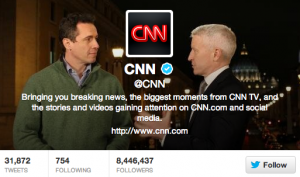 “Twitter is a frenemy,” said Jeff Zucker, CNN’s new president, as reported by MediaShift. Jeff Zucker was describing the cable news network’s relationship with social media and added, “the network uses, relies on — and is scared by — social media.”
“Twitter is a frenemy,” said Jeff Zucker, CNN’s new president, as reported by MediaShift. Jeff Zucker was describing the cable news network’s relationship with social media and added, “the network uses, relies on — and is scared by — social media.”
Twitter had a marquee moment last week, particularly late Friday afternoon and evening, that should scare most television news outlets in the business of reporting breaking news.
That’s when Boston Marathon bombing suspect Dzhokhar Tsarnaev was cornered by police, trapped and almost bleeding to death inside a covered boat in a backyard in Watertown, Mass.
I was riding home on the commuter train and wanted an update on the manhunt. I tried checking the news sites, but there were no fluid updates. Moreover, the sites refreshed painstakingly slowly on a moving train.
So I checked my regular Twitter stream, and updates poured in persistently. I kept refreshing the stream every few seconds to import new updates and perspectives. This event resembled the OJ Simpson’s slow-motion car chase, and it was Twitter’s moment.
Twitter seized the moment with:
- Immediacy. Without following any special sources, my standard Twitter connections reported and retweeted major developments seconds after they happened — either by being on the ground, scanning police airwaves, or passing along updates from trusted sources. The discussion on Twitter typically was ahead of the major news sources.
- Context. News outlets will argue that they provide editing, filtering and fact-checking value. That may be true, but so does the crowd and the public as it scrutinizes developments and facts. In fact, the conventional news sources become one of many participants in the ongoing analysis, not the referee of it.
- Pragmatism. I underscore pragmatism because my Twitter experience was more information-based than TV, with raw, intelligent commentary from real, diverse people. Facts tended to be facts, and perspectives were to the point — unlike the mindless banter and filler commentary that accompanies most live television coverage of unfolding news events.
- Sophistication. Unlike television, Twitter is less susceptible to repeat playback of violent imagery. Do we need to see the explosions and blood spraying across the sidewalks over and over again? Similarly, Twitter is less susceptible to replays of b-roll and stock footage that don’t add any value when there is no news at that second. You have to actively select video you want to watch, so you can avoid being held hostage to it.
- Community. Television is a powerful medium because it can hold your attention and captivate your imagination, and make you feel part of a shared experience — something we all yearn for in times of crisis. But Twitter does an equally good job of this, in my opinion.
- Accessibility. Twitter is not always more accessible than television, but the signals are more digestible and require less bandwidth. In my case, riding home on a train last Friday evening, without a terrestrial radio, it was the only practical way to pick the news in real time. It was also more accessible once back at my home, where I wanted to keep up with the events but shield my five- and six-year-old kids from serious drama and sensationalism.
But there is one area where Twitter failed drastically: There were no citizen hecklers standing behind broadcast reporters, waving into the camera with funny faces and obnoxious signs. I really love that aspect of television news. It cracks me up.
This story also ran in MediaPost.

Well said Max. Great insight and all very true. Traditional news outlets should be scared.
Thanks Marcy.